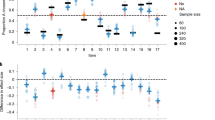Abstract
Third generation prospect theory (Schmidt et al. J Risk Uncertain 36:203–223, 2008) is a theory of choices and of judgments of highest buying and lowest selling prices of risky prospects, i.e., of willingness to pay (WTP) and willingness to accept (WTA). The gap between WTP and WTA is sometimes called the “endowment effect” and was previously called the “point of view” effect. Third generation prospect theory (TGPT) combines cumulative prospect theory for risky prospects with the theory that judged values are based on the integration of price paid or price received with the consequences of gambles. In TGPT, the discrepancy between WTP and WTA is due to loss aversion-losses have greater absolute utility than gains of the same value. TGPT was developed independently of similar developments by Birnbaum and Zimmermann (Organ Behav Hum Decis Process 74(2):145–187, 1998) and Luce (Utility of gains and losses: measurement-theoretical and experimental approaches. Erlbaum, Mahwah, 2000). This paper reviews theoretical and empirical findings, to show that TGPT fails as a descriptive model of both choices and judgments. Evidence refutes three implications of TGPT, but they are consistent with configural weight models (Birnbaum and Stegner, J Personal Soc Psychol 37:48–74, 1979) in which loss aversion is not needed to describe the results. In the configural weight models, buyers place greater weight on lower consequences, attributes or estimates of value compared to sellers, who place greater configural weight on higher aspects of an object or prospect.

Similar content being viewed by others
References
Ashby, N. J. S., Dickert, S., & Glöckner, A. (2012). Focusing on what you own: Biased information uptake due to ownership. Judgment and Decision Making, 7, 254–267.
Birnbaum, M. H. (1974). The nonadditivity of personality impressions. Journal of Experimental Psychology Monograph, 102, 543–561.
Birnbaum, M. H. (1982). Controversies in psychological measurement. In B. Wegener (Ed.), Social attitudes and psychophysical measurement (pp. 401–485). Hillsdale, N.J.: Lawrence Erlbaum Associates.
Birnbaum, M. H. (1997). Violations of monotonicity in judgment and decision making. In A. A. J. Marley (Ed.), Choice, decision, and measurement: Essays in honor of R. Duncan Luce (pp. 73–100). Mahwah, NJ: Erlbaum.
Birnbaum, M. H. (2004). Tests of rank-dependent utility and cumulative prospect theory in gambles represented by natural frequencies: Effects of format, event framing, and branch splitting. Organizational Behavior and Human Decision Processes, 95, 40–65.
Birnbaum, M. H. (2005). A comparison of five models that predict violations of first-order stochastic dominance in risky decision making. Journal of Risk and Uncertainty, 31, 263–287.
Birnbaum, M. H. (2008). New paradoxes of risky decision making. Psychological Review, 115, 463–501.
Birnbaum, M. H., & Bahra, J. P. (2012). Separating response variability from structural inconsistency to test models of risky decision making. Judgment and Decision Making, 7, 402–426.
Birnbaum, M. H., & Beeghley, D. (1997). Violations of branch independence in judgments of the value of gambles. Psychological Science, 8, 87–94.
Birnbaum, M. H., Coffey, G., Mellers, B. A., & Weiss, R. (1992). Utility measurement: Configural-weight theory and the judge’s point of view. Journal of Experimental Psychology: Human Perception and Performance, 18, 331–346.
Birnbaum, M. H., & Navarrete, J. B. (1998). Testing descriptive utility theories: Violations of stochastic dominance and cumulative independence. Journal of Risk and Uncertainty, 17, 49–78.
Birnbaum, M. H., & Stegner, S. E. (1979). Source credibility in social judgment: Bias, expertise, and the judge’s point of view. Journal of Personality and Social Psychology, 37, 48–74.
Birnbaum, M. H., & Sutton, S. E. (1992). Scale convergence and utility measurement. Organizational Behavior and Human Decision Processes, 52, 183–215.
Birnbaum, M. H., & Veira, R. (1998). Configural weighting in judgments of two- and four-outcome gambles. Journal of Experimental Psychology: Human Perception and Performance, 24, 216–226.
Birnbaum, M. H., Yeary, S. (1998). Tests of Stochastic Dominance, Cumulative Independence, Branch Independence, Coalescing, Event-Splitting Independence, and Asymptotic Independence in Buying and Selling Prices. Unpublished manuscript.
Birnbaum, M. H., Yeary, S., Luce, R. D., & Zhao, L. (2016). Empirical evaluation of four models for buying and selling prices of gambles. Journal of Mathematical Psychology, 75, 183–193.
Birnbaum, M. H., & Zimmermann, J. M. (1998). Buying and selling prices of investments: Configural weight model of interactions predicts violations of joint independence. Organizational Behavior and Human Decision Processes, 74(2), 145–187.
Edwards, W. (1954). The theory of decision making. Psychological Bulletin, 51, 380–417.
Johnson, J. B., & Busemeyer, J. R. (2005). A dynamic, stochastic, computational model of preference reversal phenomena. Psychological Review, 112, 841–861.
Luce, R. D. (2000). Utility of gains and losses: Measurement-theoretical and experimental approaches. Mahwah, NJ: Erlbaum. Errata: see http://www.imbs.uci.edu/files/personnel/luce/luce.html.
Luce, R. D., & Fishburn, P. C. (1991). Rank- and sign-dependent linear utility models for finite first order gambles. Journal of Risk and Uncertainty, 4, 29–59.
Kahneman, D., & Tversky, A. (1979). Prospect theory: An analysis of decision under risk. Econometrica, 47, 263–291.
Quiggin, J. (1982). A theory of anticipated utility. Journal of Economic Behavior and Organization, 3, 324–345.
Quiggin, J. (1993). Generalized expected utility theory: The rank dependent model. Boston: Kluwer Academic.
Samuelson, W., & Zeckhauser, R. (1988). Status quo bias in decision making. Journal of Risk and Uncertainty, 1, 7–59.
Schmidt, U., Starmer, C., & Sugden, R. (2008). Third-generation prospect theory. Journal of Risk and Uncertainty, 36, 203–223.
Thaler, R. (1980). Toward a positive theory of consumer choice. Journal of Economic Behavior and Organization, 1, 39–60.
Tversky, A., & Kahneman, D. (1991). Loss aversion in riskless choice: A reference-dependent model. Quarterly Journal of Economics, 106(4), 1039–1061.
Tversky, A., & Kahneman, D. (1992). Advances in prospect theory: Cumulative representation of uncertainty. Journal of Risk and Uncertainty, 5, 297–323.
Wakker, P. (2011). Prospect theory: For risk and ambiguity. Cambridge, UK: Cambridge University Press.
Author information
Authors and Affiliations
Corresponding author
Additional information
Support was received from National Science Foundation Grant, SES DRMS-0721126. I thank Ulrich Schmidt for comments on an earlier draft.
Rights and permissions
About this article
Cite this article
Birnbaum, M.H. Empirical evaluation of third-generation prospect theory. Theory Decis 84, 11–27 (2018). https://doi.org/10.1007/s11238-017-9607-y
Published:
Issue Date:
DOI: https://doi.org/10.1007/s11238-017-9607-y




